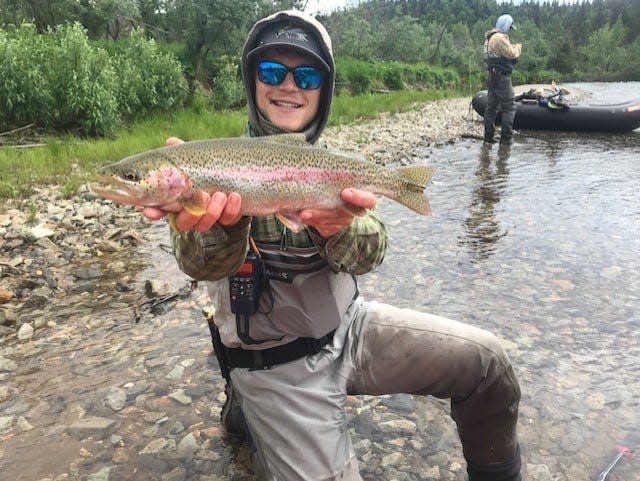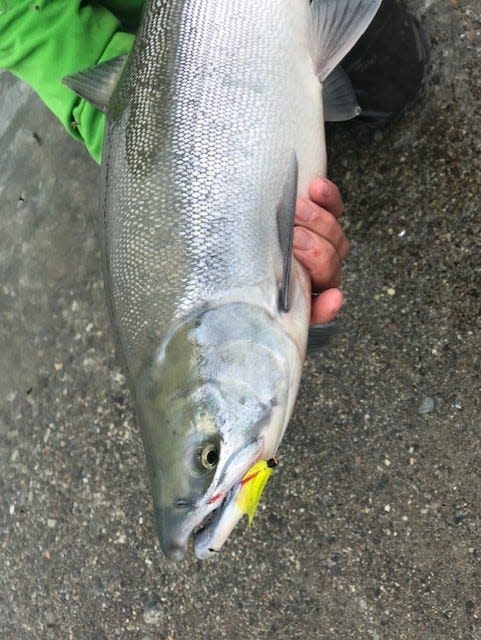Leggett: Salmon gotta do what salmon gotta do, and Alaska is the best place to catch them

KVICHAK RIVER, Alaska — A screaming east wind was punching up big surf waves half a mile out on Lake Iliamna and scraping the top surface off the sandy shoreline where the lake opened up and sent its frigid water coastward toward Bristol Bay.
The waves crashed into the far shoreline, sounding like the early tides of a hurricane, booming whitewater breakers that would have discouraged all but the toughest and neediest anglers from trying to catch any of the thousands of sockeye salmon that poured into the river at the start of their annual spawning run.
Nature’s greatest mystery was once again playing out in midsummer in the Bristol Bay region of southwest Alaska: millions of salmon, currently kings and sockeyes that will be replaced by silvers in August and September, all fighting their way homeward to the locations where they were born and became salmon themselves.
A trip worth waiting for
Sockeyes spend as long as four years in freshwater before switching over to saltwater, where they live for another one to three years. They succumb to the primal surge to migrate to freshwater and spawn. They seek out the water that tells them they should head upriver and begin the journey that will take them up rivers like the Kvichak (pronounced Kwee-zhak) that pull their water from Lake Iliamna.
“These salmon came up the Kvichak from Bristol Bay last night, which is 70 miles that way,” says Newhaven Lodge head guide Drew Pozzi, waving his arm in the general direction of the coastal mouth of the river. “They come up the river to where we are, and then they disperse and travel the river where they were born.”
Those rivers include the Gibraltar, Newhalen, Tazimina and Copper, all drawing their flows from gigantic Lake Iliamna, a glacial holdover from the Ice Age and home of the best rainbow trout fishing in Alaska. The lake is huge, so vast that a collection of seals have migrated in and stayed, living well off the salmon and trout.
Leggett: One old fishing photo made for the perfect Father's Day gift
Pozzi and fellow guide Fred Sims, son of lodge owner Bill Sims, had been monitoring the state’s salmon count for the Kvichak and knew where they could land a float plane and walk their anglers into the fish. We stood on the southern shore of the river, the wind lashing our backs and sending sand screaming down our necks and into our hair, where the individual grains settled in and became an annoying kind of semi toupee.

The only thing worse would be the mosquitoes, white socks and other assorted insects that would suddenly swarm anglers standing on the beach. We could see our fellows executing odd dance moves on the beach, standing around the campfire, the only place that offered any kind of relief from the bugs, swatting and sweeping them into the air and away from their exposed skin. At times they’d suddenly start gagging and spitting as they tried to rid themselves of bugs they’d sucked into their gullets.
The best place to spend July, Austin? Alaska.
Pozzi stands on the beach, just a couple of feet out of the water, demonstrating the casting technique we would use to catch the fish. “Right arm goes over in a kind of roll cast and the fly lands about 12 o’clock from your body,” he says. "Let it drift to about 11 o’clock and then pick it up. If they haven’t hit it by then you’re too close and they won’t hit the fly.”
The fly would only travel 15 to 20 feet into the river, and the drift would bring it back into the stream of salmon passing right against the shoreline. Lodge guest Kaari Wicklund dropped her salmon fly into the perfect spot, and the rest of us could only watch as she began a nearly 15-minute fight against the 8- or 9-pound fish that took her well into her backing and 150 yards downstream. Guide Cody Darling eventually corralled the fish in ankle deep water down near where we’d beached the johnboats brought up from the planes.
Leggett: Fishing for bream with my grandfather a treasured memory
Anybody could have used a fly rod to hook these fish, which were so fresh and strong they would take the fly and then rip off a 20- to 30-yard screaming run and then settle into a vigorous fight against rod and current.
“We don’t have to foul hook these fish,” Pozzi told me. “They are right out of saltwater, and they will take the fly when they see it.”
As the salmon move farther into the physical decline that will end with their deaths after spawning, they begin to break down and assume the striking red bodies and green heads that signal their spawning readiness, and the fish will usually ignore any fly that’s presented to them.
These salmon, however, still were feeding as they reached the area where the river meets the lake, and a dozen of us caught limits of five fish that would end with sore shoulders and arms from fighting the fish on fly rods.
Back at the lodge, guides set up a cleaning table where they filleted the fish for each angler, shrink-wrapping each fillet and placing them into a soft-sided back that could keep them frozen through airports and drives home.
Away from the salmon, rainbow trout were showing up in great numbers and prodigious sizes on almost every river. Fishing from an inflatable boat on the picturesque Copper River, I landed 15 fish over 20 inches in one day, completing the trip with a thick-shouldered 27-inch brute that took the fly little more than 100 yards from our pickup point.
The fishing was great all week, especially for the sockeyes and sausage-shaped rainbows. My wife, Rana, and I left the lodge, as usual, with tears in our eyes and fear in our hearts at the heat wave that was ripping apart the Hill Country.
This article originally appeared on Austin American-Statesman: Fishing for salmon is best done in an Alaskan river
